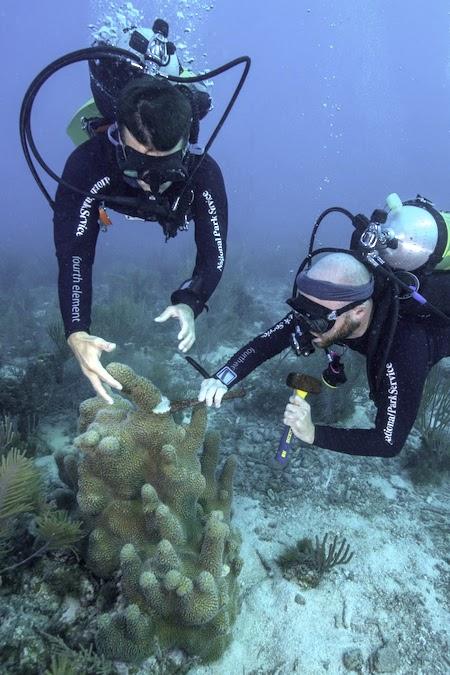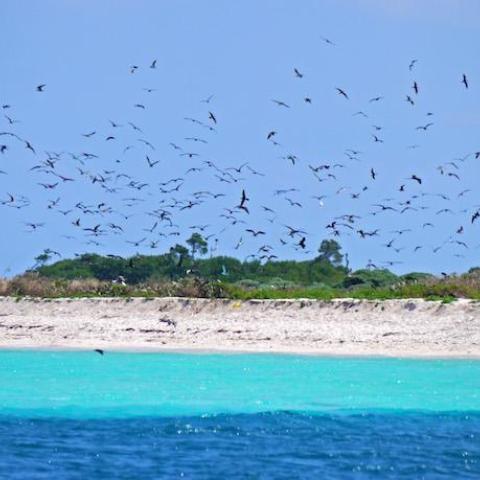
Samples of a rare Pillar coral were taken from Dry Tortugas National Park for preservation/NPS, Brett Seymour
Coral reefs host the greatest biodiversity of any marine ecosystem on Earth, supporting one-quarter of all marine life worldwide. In the United States, the National Park Service along with other agencies within the Department of the Interior have jurisdiction over 3.6 million acres of reef habitats across 88 ocean and coastal parks, including 10 national parks.
While work is being done within those park waters to try to maintain healthy reefs, at Dry Tortugas National Park in Florida pieces of a rare coral have been taken from different colonies for preservation in a maintained and monitored aquarium setting at the Phillip and Patricia Frost Museum of Science in Miami.
The pieces came from previously unknown pillar coral (Dendrogyra cylindrus) colonies within the park. These new colonies may have a unique genetic makeup, or genotype, and may be more resilient to stressors like Stony Coral Tissue Loss Disease, found recently at the national park.
“This rescue mission may help the National Park Service preserve a threatened population of coral and protect the genetic diversity of this species in Florida,” said Pedro Ramos, superintendent of Everglades and Dry Tortugas national parks. “We are so grateful for the collaboration with our partners throughout Florida’s Coral Reef on the disease response and the efforts to increase our understanding of coral science.”
Pillar coral is a rare coral species warranting concern and is listed as threatened under the Endangered Species Act. It is one of about 30 coral species currently impacted by Stony Coral Tissue Loss Disease. A recent study shows that over 85 percent of the genotypes of pillar corals on Florida’s Coral Reef have perished, so rescuing this new potential genotype is critical for the survival of the species. Many of the remaining colonies in the wild, including the ones found in the park, are threatened with extinction by disease.
Until recently, pillar corals in the park were thought to be restricted to a single location at a site called Magic Castles, and all the colonies found there are comprised of a single genotype. Given the distance between the Magic Castles site and the newly discovered pillar coral colonies, there is a chance that the new colonies will have a different genotype, a park release explained. An increase in pillar coral genetic diversity would likely improve the probability of successful restoration efforts if researchers were able to facilitate reproduction between colonies at the two sites now known to exist in the park.
The August 6 rescue mission focused on the proactive collection of four pillar coral fragments from the new colonies for further research in ongoing coral preservation efforts. The Florida Fish and Wildlife Conservation Commission’s Fish and Wildlife Research Institute assisted the National Park Service with the coral rescue, picking up the corals once they arrived via NPS Motor Vessel Fort Jefferson in Key West and transporting them to the Phillip and Patricia Frost Museum of Science in Miami.
Staff from the National Oceanic and Atmospheric Administration and Nova Southeastern University also provided support and coordination during the rescue mission by sharing best collection and transport practices and identifying aquaria for long-term preservation.
The Frost Science Museum will hold the coral fragments in quarantine and keep them isolated from the rest of their coral collection through at least mid-September. Preserving the fragments in an aquarium enables further study, including genetic analyses, and safekeeping for possible replanting in the future.

The NPS rescue will inform future coral restoration initiatives and protect pillar coral like the one pictured here, found at the Dry Tortugas National Park Magic Castles site. The white lesions at the base of the coral are early signs of the fatal Stony Coral Tissue Loss Disease. NPS Photo / Brett Seymour
Storing these samples will allow biologists to analyze the rescued pillar coral fragments to determine if the colonies in this location represent a unique genotype. This is the park’s third coral rescue, following rescues in July 2019 and May 2020 during which park staff and partners successfully collected healthy corals ahead of the Stony Coral Tissue Loss Disease front. Pillar coral was not collected in the previous rescues because the previously single known genotype was already represented in collections maintained by the Florida Aquarium.
Impacting Florida’s Coral Reef since 2014, Stony Coral Tissue Loss Disease was only recently found at Dry Tortugas National Park when the park’s Coral Response Team observed it this year on May 29. This infectious, water-borne disease impacts hard coral species and has caused significant damage to reefs in Florida and throughout the Caribbean. The Coral Response Team is committed to conducting surveys and intervention. To date, they have observed Stony Coral Tissue Loss Disease at 15 more locations in the park. The disease moves rapidly through the reef community, and resource managers estimate that the disease currently affects a 30 square mile area within the park.
Located 70 miles west of Key West, Dry Tortugas National Park protects one of the most pristine and diverse portions of Florida’s Coral Reef. Originally established in 1935 as a national monument to protect historic Fort Jefferson, the area was expanded and designated as a national park in 1992 to include the preservation of the diverse island and marine ecosystems of the Dry Tortugas. Today, the park is a popular recreation destination for snorkeling, diving, fishing and boating.



 Support Essential Coverage of Essential Places
Support Essential Coverage of Essential Places






